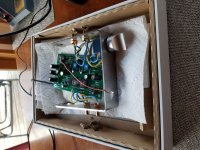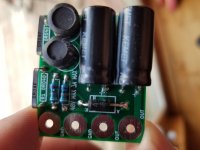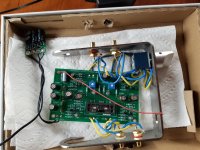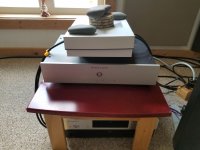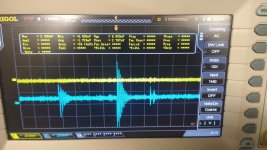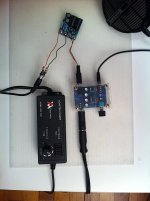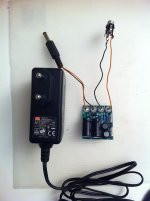Ok, here's mine. Pretty sure I win the fugliest pageant, but it sounds glorious.
Many thanks to the designers, Nelson Pass and Mark Johnson, and to konst for the filter board donation. I don't have any measuring equipment, and for sure it sounded great before the filter board install, but I swear the soundstage got deeper after the smps filter install (using OB speakers). Fun, easy, cheap, better--what's not to like?!
Oh, and yes, the rocks are magic (korg ringing mitigation magic)
limits
Many thanks to the designers, Nelson Pass and Mark Johnson, and to konst for the filter board donation. I don't have any measuring equipment, and for sure it sounded great before the filter board install, but I swear the soundstage got deeper after the smps filter install (using OB speakers). Fun, easy, cheap, better--what's not to like?!
Oh, and yes, the rocks are magic (korg ringing mitigation magic)
limits
Attachments
Great minds… although I have to say I disagree on the the very flattering « expert », especialy considering the people here, far less more expert than me… but thanks for the kind words 
So… I am too late to say how this passive filter measures, this has been done a couple of times now and we could all see it was doing a very good job on the oscilloscope (I do confirm).
However, this is not about measurements only, but audio, and the big question is: does it hit its target, ie does it enhence the sound of audio devices by helping SMPS to give a cleaner current ?
That’s what I wanted to find out, and for that I carried 2 tests on both (identical) filters I have built, thanks to Mark and Konst. One with a cheap chinese SMPS and a very basic HP amp with little defense re PS dirt, the other one with my B1 Korg.
Just to discard one variable, in all my various tests both filters I built sounded identical and this consistency is a credit to its design as that applied with different SMPS.
Let’s start with the chinese SMPS, a few bucks, but not too bad doing on an oscilloscope and capable of delivering up to 3A at 30V, so around 10 times the needs of my HP amp. Call it large… with an easy job, for sure most PS are not that overdimensioned and have a much harder job, probably producing as much if not more junk. On top, Mark’s device adds filtering capacity C in a large way in that set up, regardless the RL…C filtering.
I tried with and without Mark’s filter and that little device worked for me !
More resolution… every sound is better chiseled with that device.There is more depth and width to the soundstage, far more air - music sounds less compressed, more moving around.
The bass is better defined with a bit more impulse/ drive and a clearly better resonance /flowing echo.
Highs are clearer and more precise, yet also less agressive and not realy brighter, just more reallistic.
All registers are better integrated and music seems to flow better. No downside yet whatsoever, not even too bright, or too dark, or too revealing or bad records… I like it.
Note though these are still small improvements, some you can still hear in direct comparison, but not day and night despite the very average PS set up. On my scale, this is the difference between very average cheap electrolytic cap and the very best electrolytic ones in the signal path. It won’t turn your Beetle into a Ferrari, nor really change the overall sonic caracter of the unit (which is a positive for a passive filter), but the difference is there though and with astonishingly similar improvements to (much) better caps in the signal path.
So… I am too late to say how this passive filter measures, this has been done a couple of times now and we could all see it was doing a very good job on the oscilloscope (I do confirm).
However, this is not about measurements only, but audio, and the big question is: does it hit its target, ie does it enhence the sound of audio devices by helping SMPS to give a cleaner current ?
That’s what I wanted to find out, and for that I carried 2 tests on both (identical) filters I have built, thanks to Mark and Konst. One with a cheap chinese SMPS and a very basic HP amp with little defense re PS dirt, the other one with my B1 Korg.
Just to discard one variable, in all my various tests both filters I built sounded identical and this consistency is a credit to its design as that applied with different SMPS.
Let’s start with the chinese SMPS, a few bucks, but not too bad doing on an oscilloscope and capable of delivering up to 3A at 30V, so around 10 times the needs of my HP amp. Call it large… with an easy job, for sure most PS are not that overdimensioned and have a much harder job, probably producing as much if not more junk. On top, Mark’s device adds filtering capacity C in a large way in that set up, regardless the RL…C filtering.
I tried with and without Mark’s filter and that little device worked for me !
More resolution… every sound is better chiseled with that device.There is more depth and width to the soundstage, far more air - music sounds less compressed, more moving around.
The bass is better defined with a bit more impulse/ drive and a clearly better resonance /flowing echo.
Highs are clearer and more precise, yet also less agressive and not realy brighter, just more reallistic.
All registers are better integrated and music seems to flow better. No downside yet whatsoever, not even too bright, or too dark, or too revealing or bad records… I like it.
Note though these are still small improvements, some you can still hear in direct comparison, but not day and night despite the very average PS set up. On my scale, this is the difference between very average cheap electrolytic cap and the very best electrolytic ones in the signal path. It won’t turn your Beetle into a Ferrari, nor really change the overall sonic caracter of the unit (which is a positive for a passive filter), but the difference is there though and with astonishingly similar improvements to (much) better caps in the signal path.
Attachments
Now the B1 Korg. Mine is a bit special as it has a low ripple quality SMPS, already an excellent filtering courtesy of M. Pass and on top the PS caps have been doubled in capacity to enhence further the original filtering with some further minor positive effect.
I didn’t expect this filter to make any improvement here, given the unit sounds already excellent to me and different PS (such as linear regulated etc.) brought a slightly different caracter (tad more bass etc.) but it was always a trade off and a matter of taste - at the end I prefered to stick to the original PS.
It is not easy to carry out comparisons with the B1 Korg. That is because a) you need it to stabilise, you can’t just switch in on and off / listen on the fly, so you need a lot of listening time and effort, but mainly because b) it is so addictive that it is very difficult to concentrate on listening impressions without being carrying away ! J
However, for me the filter worked here aswell, although I really didn’t expect it to work at all. Basicaly the same as for the cheap chinese unit, but with a much lower amplitude, say 60% of the benefits (+2 in my scale). It gets harder to find it out, requires careful listening, but the main outstanding figures are IMHO :
- improved drive / punch in the lower bass (and that can’t be in that case just the filter’s cap increase, something is happening here), very nice flesh and speed
- better resolution overall, more easy to pick in the higher frequencies (those finding this unit somewhat agressive in the treble, something I can’t back up at all for myself, should try this filter as it makes the treble more precise and yet more natural)
- A tad wider soundstage and overall better register integration, although the B1 Korg didn’t really need any improvement on that it is was marginal, but still not a negative of course
At the end the most noticeable things are the bass drive and refined treble. But that’s with careful listenings and all IMHO. In terms of gain, I would say the magnitude is similar/slightly more to the PS capacity doubling I did, so overall a small step, on the verge of what is noticeable, let’s be realistic. We aren’t transforming the unit here.
So a small gain here only, due probably to the power supply being well designed already, not a big step… but on the other hand it doesn’t cost a leg and it manages to enhence a device I thought already close to perfection and consistency, so every increase from there is already incredible.
What about me now ? Well, I will integrate this filter to the B1 Korg permanently and given its low cost and ease of built I can only think that it would be benefical to most B1 Korg owners aswell, especialy those that are not using an extra low ripple with extra caps PS : I can only think that the improvements then are going to be greater while this filter can easily be added as an external device and requires no changes / desoldering on the B1 Korg ! Easy job, easy to try, why shouldn’t you ?
Further, I could see myself « advertising » that little unit to friends using wall wart SMPS for their DAC etc. For that reason, and also because I believe it defo deserves support, should there be another batch please count me in for a few boards– more than happy to support, not just financialy, spreading the good word (I will also post in the B1 Korg thread).
Last but not least, that has triggered me to change my plans regarding a larger amp’s SMPS filter, but that is without Mark’s blessing and excellent work. However, should it work, than Mark will deserve credits on this aswell as being inspirational.
Thanks Mark and Konst for having enabled me to discover a worthful addition I would have never suspected: great job Gentlemen, and thanks for sharing !
Claude
I didn’t expect this filter to make any improvement here, given the unit sounds already excellent to me and different PS (such as linear regulated etc.) brought a slightly different caracter (tad more bass etc.) but it was always a trade off and a matter of taste - at the end I prefered to stick to the original PS.
It is not easy to carry out comparisons with the B1 Korg. That is because a) you need it to stabilise, you can’t just switch in on and off / listen on the fly, so you need a lot of listening time and effort, but mainly because b) it is so addictive that it is very difficult to concentrate on listening impressions without being carrying away ! J
However, for me the filter worked here aswell, although I really didn’t expect it to work at all. Basicaly the same as for the cheap chinese unit, but with a much lower amplitude, say 60% of the benefits (+2 in my scale). It gets harder to find it out, requires careful listening, but the main outstanding figures are IMHO :
- improved drive / punch in the lower bass (and that can’t be in that case just the filter’s cap increase, something is happening here), very nice flesh and speed
- better resolution overall, more easy to pick in the higher frequencies (those finding this unit somewhat agressive in the treble, something I can’t back up at all for myself, should try this filter as it makes the treble more precise and yet more natural)
- A tad wider soundstage and overall better register integration, although the B1 Korg didn’t really need any improvement on that it is was marginal, but still not a negative of course
At the end the most noticeable things are the bass drive and refined treble. But that’s with careful listenings and all IMHO. In terms of gain, I would say the magnitude is similar/slightly more to the PS capacity doubling I did, so overall a small step, on the verge of what is noticeable, let’s be realistic. We aren’t transforming the unit here.
So a small gain here only, due probably to the power supply being well designed already, not a big step… but on the other hand it doesn’t cost a leg and it manages to enhence a device I thought already close to perfection and consistency, so every increase from there is already incredible.
What about me now ? Well, I will integrate this filter to the B1 Korg permanently and given its low cost and ease of built I can only think that it would be benefical to most B1 Korg owners aswell, especialy those that are not using an extra low ripple with extra caps PS : I can only think that the improvements then are going to be greater while this filter can easily be added as an external device and requires no changes / desoldering on the B1 Korg ! Easy job, easy to try, why shouldn’t you ?
Further, I could see myself « advertising » that little unit to friends using wall wart SMPS for their DAC etc. For that reason, and also because I believe it defo deserves support, should there be another batch please count me in for a few boards– more than happy to support, not just financialy, spreading the good word (I will also post in the B1 Korg thread).
Last but not least, that has triggered me to change my plans regarding a larger amp’s SMPS filter, but that is without Mark’s blessing and excellent work. However, should it work, than Mark will deserve credits on this aswell as being inspirational.
Thanks Mark and Konst for having enabled me to discover a worthful addition I would have never suspected: great job Gentlemen, and thanks for sharing !
Claude
Attachments
I like my B1 Korg with negative H2 and less harmonics / spice than suggested as starting point in Papa’s paper. Just as a side note, the filter didn’t noticeably affect the bias voltage of the B1 Korg, so the effects are not due to bias changes (as this affects the sound)… and are anyway very different from what a small bias change would bring around my chosen bias.
It is indeed Mark’s filter at play…
It is indeed Mark’s filter at play…
Claude, thank you SO much for your thoughtful reviews. I'm sure everyone who is building a SMPS post-filter, or considering building a filter, will be grateful for your experiences and listening impressions, which you've shared so generously.
The evidence in favor of TRYING a filter, at least experimentally, seems reasonably compelling
The evidence in favor of TRYING a filter, at least experimentally, seems reasonably compelling
- It's small and very inexpensive
- It's a fast "build": just nine thru hole components to solder
- It can be installed quickly, and removed quickly, for A/B listening tests -- except for Korg warmup delays!
- diyAudio members who've measured it, really like the measurement results
- Members who've listened to it, really like the sonic results
If you are in need of a tutorial on filter design, Omicron Labs sponsored these discussions by Ali Shirsavar of Biricha Digital Power -- consultants who get products through their EMI tests.
Discussion includes Middlebrook Stability Criteria for common mode filters -- I just link Chapter 8 -- but you can scroll to the beginning:
EMC Filter Design Part 8: EMC Common Mode Filter Design and Component Selection - YouTube
Discussion includes Middlebrook Stability Criteria for common mode filters -- I just link Chapter 8 -- but you can scroll to the beginning:
EMC Filter Design Part 8: EMC Common Mode Filter Design and Component Selection - YouTube
PO89ZB is a Low Pass Filter. It rejects high frequency noise created by the Switch Mode Power Supply, while allowing "low frequency" signals (like zero Hertz DC !) to flow unimpeded. You want to learn more about LC Low Pass Filters.
I think these three Youtube videos look very approachable. Spend an hour watching the three of them and see what you think.
1. (easiest) Stan Gibilisco video
2. techgurukula video
3. (slowly works through an example) Chris's Workbench
I think these three Youtube videos look very approachable. Spend an hour watching the three of them and see what you think.
1. (easiest) Stan Gibilisco video
2. techgurukula video
3. (slowly works through an example) Chris's Workbench
If you are in need of a tutorial on filter design, Omicron Labs sponsored these discussions by Ali Shirsavar of Biricha Digital Power -- consultants who get products through their EMI tests...
Jack, thanks VERY much for that link!
I think the part of that video series which applies to PO89ZB the most, is probably
Part 4: Differential Mode Filter Design Down To The Component Level
Be sure to drink one or two cups of strong coffee before watching, and then prepare for the classic MIND BLOWN reaction
 when you get to timestamp 3:38 of the video. Those horrible, nonlinear resonance equations are reduced to simple pen-and-ruler operations on the "impedance paper".
when you get to timestamp 3:38 of the video. Those horrible, nonlinear resonance equations are reduced to simple pen-and-ruler operations on the "impedance paper".here is .pdf -- print me! download me!
Watching this one video won't magically convert you into an all-knowing EE professor in twelve minutes, but it probably will awaken your long-dormant memories of Signals And Systems, Laplace Transforms, damping, Q, and so forth.
- Home
- Source & Line
- Analog Line Level
- PO89ZB , an inline DC filter for SMPS wall warts . Preamps, HPA, Korg NuTube, etc
